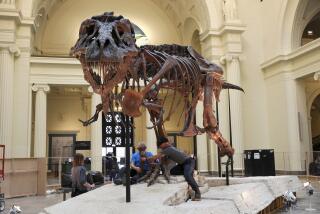âDuelingâ dinosaur skeletons could fetch $9 million at auction
A pair of fossil dinosaur skeletons dubbed the Montana Dueling Dinosaurs is headed for auction rather than straight to a museum. The duo, discovered touching on a Montana ranch in 2006, appear to be relatives of Tyrannosaurus rex and Triceratops locked in mortal combat.
The long-dead dinosaurs, up on the auction block for Nov. 19, are valued at $7 million to $9 million, according to auction house Bonhams.
Itâs unlikely a museum would be able to afford that price tag, said Luis Chiappe, a paleontologist at the Natural History Museum of Los Angeles County who was not involved in the find.
âI really doubt that there will be any museum with the kind of money available to purchase them, which is unfortunate,â he said. âIdeally it should remain in public trust.â
The fossils â which are nearly complete, and even include a little skin tissue, according to Bonhams â could potentially provide researchers with a wealth of information, Chiappe said.
âThese interactions in the fossil record are extremely rare,â Chiappe said, stressing that very little is known about the so-called dueling dinosaurs.
The skeletons may not look pretty right now, half-buried as they are in chunks of the original rock in which they were found and then wrapped in plaster. But this makes them much more scientifically valuable than if they were cleaned and put on display. Frozen in the rock, the bones help scientists understand how the animalâs limbs would have naturally moved together, and shows them what the dino was doing in its final moments.
âIf they were extracted and mounted, forget about it,â Chiappe said. âYouâre never going to figure it out.â
Also, analyzing the sediment around the bones can help determine where these two fossils originated â because it isnât yet entirely clear that they were fighting, Chiappe said, âduelingâ nickname notwithstanding.
âIf you want to prove or determine whether these animals died in some kind of combat, you really need to look carefully at the sediments,â Chiappe said. âThere are a number of things that need to be determined before you say, âOh, these animals killed each other in a duel.ââ
Perhaps the carnivore had come to scavenge the herbivoreâs already-dead body, Chiappe said. Perhaps it had died far away and its body had somehow ended up right by its fossil companionâs corpse.
Chiappe pointed to a famous example where a double-dino find was not as it first seemed. Paleontologists long thought that a carnivorous dinosaur called Coelophysis was a cannibal, because of a 1947 fossil from New Mexico that appeared to have bits of a young Coelophysis in the belly of an older one. Researchers recently proved this idea wrong â the two fossil bodies were simply crushed on top of each other.
This realization forced âa revision of a popular story of dinosaur behavior that has been repeated many times in the scientific literature, popular media, and museum exhibits,â according to the American Museum of Natural History in New York.
But if the Montana duo does turn out to be dueling, itâs an extremely rare find, Chiappe said. To his knowledge, he said, only one other pair has been found: two fighting dinosaurs from the Gobi desert. This prehistoric brawl is now considered by Mongolia to be a national treasure.
Whatever the animals were up to when they died, they could provide a wealth of valuable information as individuals. The Triceratops relative, which comes from the genus Ceratopsia, may be a whole new species, according to Bonhams.
As for the fossil carnivore, itâs unclear whether it was a Nanotyrannus, or simply a juvenile T. rex. It may even be that all fossils known as Nanotyrannus are simply young versions of T. rex, Chiappe said. Having such a fully articulated skeleton could help solve that mystery, he said.







